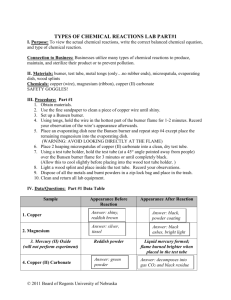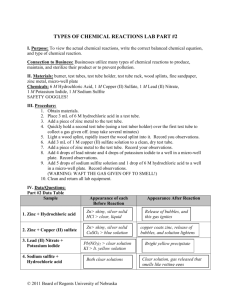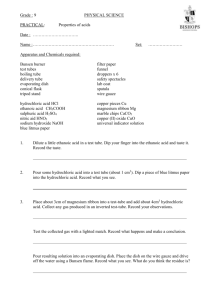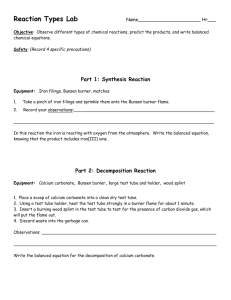TYPES OF CHEMICAL REACTIONS LAB
advertisement
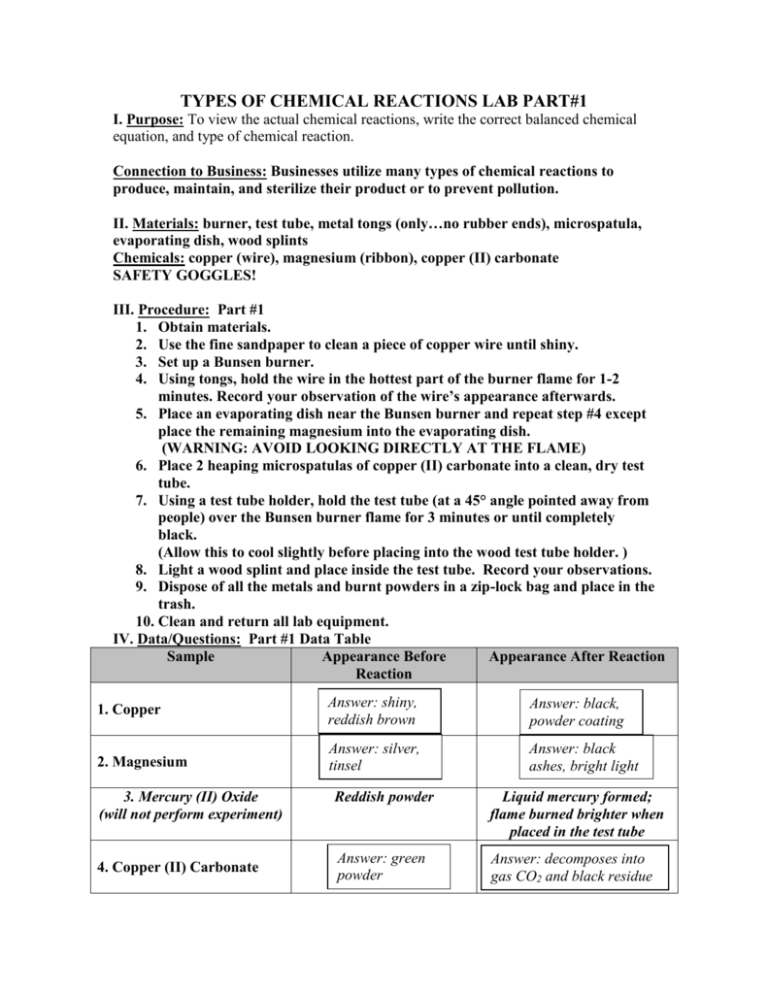
TYPES OF CHEMICAL REACTIONS LAB PART#1 I. Purpose: To view the actual chemical reactions, write the correct balanced chemical equation, and type of chemical reaction. Connection to Business: Businesses utilize many types of chemical reactions to produce, maintain, and sterilize their product or to prevent pollution. II. Materials: burner, test tube, metal tongs (only…no rubber ends), microspatula, evaporating dish, wood splints Chemicals: copper (wire), magnesium (ribbon), copper (II) carbonate SAFETY GOGGLES! III. Procedure: Part #1 1. Obtain materials. 2. Use the fine sandpaper to clean a piece of copper wire until shiny. 3. Set up a Bunsen burner. 4. Using tongs, hold the wire in the hottest part of the burner flame for 1-2 minutes. Record your observation of the wire’s appearance afterwards. 5. Place an evaporating dish near the Bunsen burner and repeat step #4 except place the remaining magnesium into the evaporating dish. (WARNING: AVOID LOOKING DIRECTLY AT THE FLAME) 6. Place 2 heaping microspatulas of copper (II) carbonate into a clean, dry test tube. 7. Using a test tube holder, hold the test tube (at a 45° angle pointed away from people) over the Bunsen burner flame for 3 minutes or until completely black. (Allow this to cool slightly before placing into the wood test tube holder. ) 8. Light a wood splint and place inside the test tube. Record your observations. 9. Dispose of all the metals and burnt powders in a zip-lock bag and place in the trash. 10. Clean and return all lab equipment. IV. Data/Questions: Part #1 Data Table Sample Appearance Before Appearance After Reaction Reaction 1. Copper Answer: shiny, reddish brown Answer: black, powder coating 2. Magnesium Answer: silver, tinsel Answer: black ashes, bright light 3. Mercury (II) Oxide (will not perform experiment) 4. Copper (II) Carbonate Reddish powder Liquid mercury formed; flame burned brighter when placed in the test tube Answer: green powder Answer: decomposes into gas CO2 and black residue 1. Copper (II) and magnesium burn to form new compounds. Both react with oxygen to form oxides of each metal. Write a balanced chemical equation for each reaction below. Answer: 2Cu + O2 → (heat) 2CuO and 2Mg + O2 → (heat) 2MgO 2. What type of chemical reactions occurred with the copper and magnesium? Answer: Synthesis (Composition) 3. In both the mercury (II) oxide and copper (II) carbonate reactions, a gas was produced. If oxygen was produced the flame would have gotten brighter and burned more, if hydrogen was produced a “pop” and short blue flame will be produced, but if carbon dioxide was produced it would extinguish the flame. A. What gas was produced in the mercury (II) oxide reaction? Answer: oxygen B. What gas was produced in the copper (II) carbonate reaction? Answer: carbon dioxide C. Reviewing the appearance of the copper (II) carbonate after being in the flame, does it appear that copper is remaining? If, YES write copper as the product, but if NO another compound was formed. What was that compound? (Hint: Compare the substance with copper in reaction #1’s before and after.) Answer: copper oxide D. Knowing the answers to 3A, B, & C write out a balanced equation for each reaction. Answer: 2 HgO → (heat) 2Hg + O2 and CuCO3 → (heat) CuO + CO2 E. What type of reactions occurred with the mercury (II) carbonate and copper (II) carbonate? Answer: decomposition F. What type of reaction occurred when you ignited the methane of the Bunsen burner or the wood splint? Answer: combustion G. Write a chemical formula for the reaction in question #F below. Answer: CH4 + 2O2 (flame) > CO2 + 2H2O V. ________________: Explain how a person can determine what type of chemical reaction occurred. Answer: By looking at the products, as well as did the reactants separate, combine, or as in combustion was there a release of heat and light during the reaction. TYPES OF CHEMICAL REACTIONS LAB PART #2 I. Purpose: To view the actual chemical reactions, write the correct balanced chemical equation, and type of chemical reaction. Connection to Business: Businesses utilize many types of chemical reactions to produce, maintain, and sterilize their product or to prevent pollution. II. Materials: burner, test tubes, test tube holder, test tube rack, wood splints, fine sandpaper, zinc metal, micro-well plate Chemicals: 6 M Hydrochloric Acid, 1 M Copper (II) Sulfate, 1 M Lead (II) Nitrate, 1 M Potassium Iodide, 1 M Sodium Sulfite SAFETY GOGGLES! III. Procedure: 1. Obtain materials. 2. Place 3 mL of 6 M hydrochloric acid in a test tube. 3. Add a piece of zinc metal to the test tube. 4. Quickly hold a second test tube (using a test tuber holder) over the first test tube to collect a gas given off. (may take several minutes) 5. Light a wood splint, rapidly insert the wood splint into it. Record you observations. 6. Add 3 mL of 1 M copper (II) sulfate solution to a clean, dry test tube. 7. Add a piece of zinc metal to the test tube. Record your observations. 8. Add 4 drops of lead nitrate and 4 drops of potassium iodide to a well in a micro-well plate. Record observations. 9. Add 5 drops of sodium sulfite solution and 1 drop of 6 M hydrochloric acid to a well in a micro-well plate. Record observations. (WARNING: WAFT THE GAS GIVEN OFF TO SMELL!) 10. Clean and return all lab equipment. IV. Data/Questions: Part #2 Data Table Sample Appearance of each Appearance After Reaction Before Reaction 1. Zinc + Hydrochloric acid Zn> shiny, silver solid HCl > clear, liquid Release of bubbles, and this gas ignites 2. Zinc + Copper (II) sulfate Zn> shiny, silver solid CuSO4 > blue solution copper coats zinc, release of bubbles, and solution lightens Pb(NO3)2 > clear solution KI > lt. yellow solution Bright yellow precipitate 3. Lead (II) Nitrate + Potassium iodide 4. Sodium sulfite + Hydrochloric acid Both clear solutions Clear solution, gas released that smells like rotting eggs Part #2 Questions: F. Zinc reacted with hydrochloric acid to give off a gas. If oxygen was produced the flame would have gotten brighter and burned more, if hydrogen was produced a “pop” and short blue flame will be produced, but if carbon dioxide was produced it would extinguish the flame. Knowing this information, write a balanced chemical equation for zinc + hydrochloric acid as well as zinc + copper (II) sulfate. Answer: Zn + 2HCl → ZnCl2 + H2 and Zn + CuSO4 → ZnSO4 + Cu G. What type of chemical reactions occurred with the zinc? Answer: single displacement H. Lead (II) nitrate and potassium iodide was a double-displacement reaction. Knowing this information, write a balanced chemical equation. Answer: Pb(NO3)2 + 2KI → PbI2 + 2 KNO3 I. Sodium sulfite reacted with hydrochloric acid to form sodium chloride, sulfur dioxide (stinky gas usually released from volcanoes), and water. Knowing this information, write a balanced chemical equation. Answer: Na2SO3 + 2 HCl → 2 NaCl + SO2 + H2O V. Conclusion: How does a person know if a chemical reaction has occurred? Answer: There are three general ways to determine if a chemical reaction has occurred: a new substance is formed, the change cannot be reversed by physical means, and there often are new physical properties.
